Hello everyone!
This year’s national gardening week falls on the week starts on Monday, the 27thof April. Have you been celebrating with the many gardening enthusiasts of Britain? If you have not started, it is never too late to appreciate spring blossoms on the street, in the park or just at your backyard. Coming into May, it is the best time of the year for planting. In kindergarten, we begin our gardening programme with children roughly now. If you are thinking of developing a vegetable patch at home with your children, in this post, we will share with you some of our experiences on the subject of growing vegetables.
The site
For families with a garden or an allotment plot, you have the condition to plant more varieties of vegetables. For people who are living in a flat with balconies or patios, you will have to choose varieties that are suitable for growing in pots. For flats without an outdoor extension, a sunny window sill is good enough for growing herbs or some type of flowers in pots. Even in a room with less light, you still have the option of sprouting or growing indoor plants.
Acquiring seeds/ plants
During this time of the year, seeds and plants are widely available in garden centres, bigger supermarket stores, allotment shops and some hardware shops. If you prefer not to go out shopping, you can get them through online ordering. You might also be able to obtain seeds from your fridge/ vegetable cellar. For example, you can just scoop seeds out of a squash or tomato, wash off the sticky juice, dry the seeds, then plant them. Usually, the fresher the seeds are, the higher their germination rates will be. Below are a few websites you can order seeds from, but of course your choices are not limited to these:
Sowing seeds
Some vegetables are better sown directly at the spot where you want to grow them, for example, most of root vegetables or fennel. Seed potatoes, garlic bulbs and onion sets can also be planted straight in.
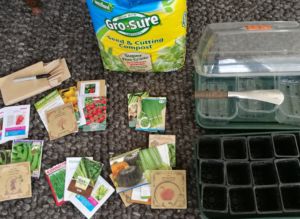
To start your seedings indoors, prepare seeds, seed compost, containers, labels, a marker and a trowel.
If you do not have seed compost, multi-purpose compost or finer potting compost can do the job too. You can also mix sand with garden soil, so the soil is lighter and airier, therefore better for growing seedings.
Then you will need two types of containers. The containers with drainage holes for sowing and the containers without drainage holes for the former ones to stand on to avoid water leaking though. If the pots are placed outside, you can skip the no drainage containers. If you do not have seed trays or pots, a good alternative is to recycle supermarket or vegetable delivery packagings. Some seeds, such as tomato, chilli and pepper seeds, germinate better in a propagator, transparent plastic containers can be up-cycled as a propagator lid.
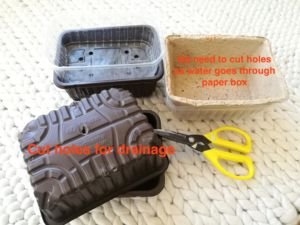
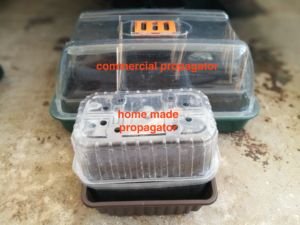
Labelling the plants helps you to identify who they are if you are not familiar with how different seedings look like. It also helps to distinguish between different varieties of the same vegetable. Ice lolly sticks can be used as plant labels if conventional labels are not available. Perhaps the easier way is just to write on the pots or write on stickers, then stick them onto the pots.
To fill a pot with soil, a trowel is not really necessary. A table spoon is a good substitute to the trowel but we do believe that most of your children would just prefer using their bare hands.
As seeds are in different sizes, seedlings require different amount of space to grow. Squash and courgette seedlings are born big, so for a 9cm pot, you just need to sow one seed whilst at the same time, you can sow 4-5 beans or peas in the same size pot. As for fast growing leafy vegetables, a 9cm pot can accommodate 6-8 seedlings. Tomato, pepper, chilli and aubergine seedlings need to grow in a protected environment for longer, so their seeds can be sown closely to start with, then the seedlings transplanted to larger pots when three to four true leaves have developed.
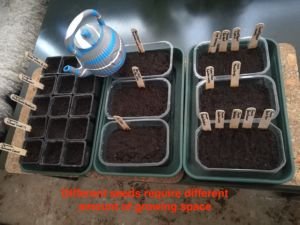
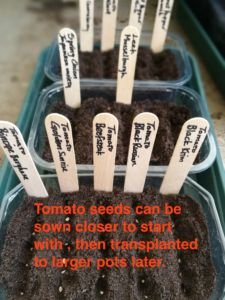
Please follow the growing instructions on your seed packages when determining how deep to sow and how far apart to plant out. You can demonstrate how to do it with one pot and let your child complete the others. After putting the seeds in the soil, remember to water. The amount of water should just be enough to keep the soil moist. Please be cautious not to over water as some seeds might rot.
Kales, oriental greens and lettuces take only three to four days to germinate; while tomatoes, peas, beans and courgettes need averagely one week; and peppers require two to three weeks. Heat loving plants like tomato, pepper and aubergine also need longer growing time, so unless you have a relatively sheltered spot or a green house for them, it might be too late to sow them in May and buying their baby plants is a better bet.

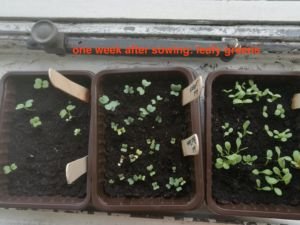
If the seeds are rare, too old thus hard to germinate or too easy to rot, sometimes we use a method called ‘chitting’ to improve the result. It is a method of starting the seed germination process before the seeds meet the soil. By providing moisture and warmth, chitting gets the first roots to emerge from a seed before planting it. It also allows your children to witness the fascinating process of seed germination in close details. The example shown here is chitting sweetcorn seeds in recycled yogurt pots with a piece of folded kitchen roll and the amount of water that is just enough to keep the seeds half soaked but not drowned.
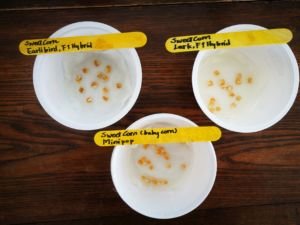
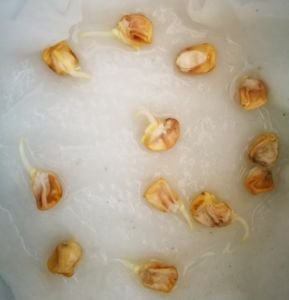
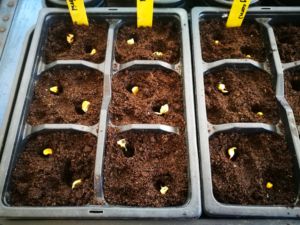
Taking care of seedlings
As the temperature is reasonably warm now, as soon as the seedlings start to grow true leaves, you can move them to a sheltered outdoor space to harden them off. If you are growing herbs inside, although you do not need to move them outdoors, it is still important to place your plants at a sunny position. Remember to water when necessary. The time for hardening off takes about 1-2 weeks depending on the weather and the variety of vegetables. Normally after your seedlings have acclimatised to the outside weather conditions and have developed a few true leaves, they can then be transplanted to their permanent growing locations.
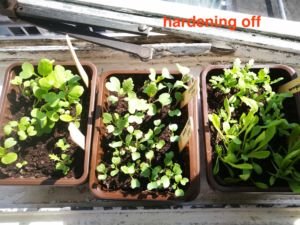

As we have mentioned before, some seedlings need to stay in a protected environment for longer. The pictures below show you how to grow them on in larger pots. To prick the closely sown seedlings out, you can just insert a finger into the side of a pot and gently wiggle the earth, then carefully take a couple of the young plants out. Once this is done, your child can first fill some soil at the bottom of the pot, then position a seedling in the middle of the pot, then properly cover the roots of the young plant with more soil. When all the seedlings are transplanted to larger pots, water well and place them at a sheltered place to grown on. These plants will be planted out after 3-4 weeks when they are strong and sturdy.
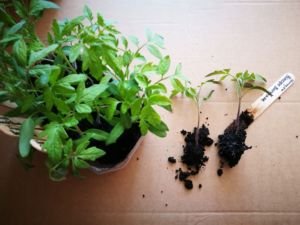
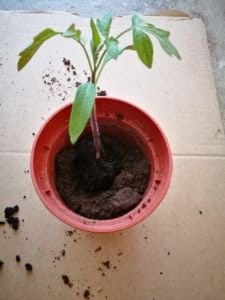

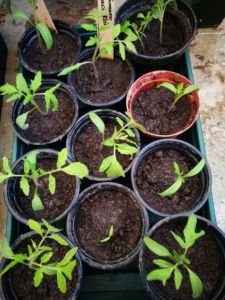
Planting out
Please read your seed packages or consult other resources for the suggested planting distances for different types of plants. Before planting the young plants out, prepare the beds in advance. For plants that need support for growing, such as peas and beans, you will need to install canes or nets in place. In general, children are enthusiastic in digging, pulling out weeds, picking out stones and racking the soil to a fine state. It is better that children are wearing suitable clothing for working outdoors, for example, rain boots, sun hats and gloves…etc. They can be over confident in their gardening ability at times. If they want to try using any sharp, heavy or long tools, and you judge that these tools are not dangerous, please also make sure that you explain to them how to use the tool and that you are near to supervise them. Children’s experiments in garden can be absolutely amazing or shocking at times.
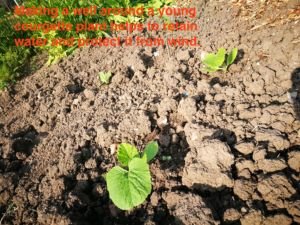
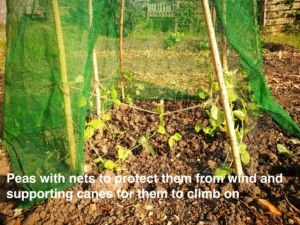
Have a wonderful gardening time with your children this summer!

Leave A Comment